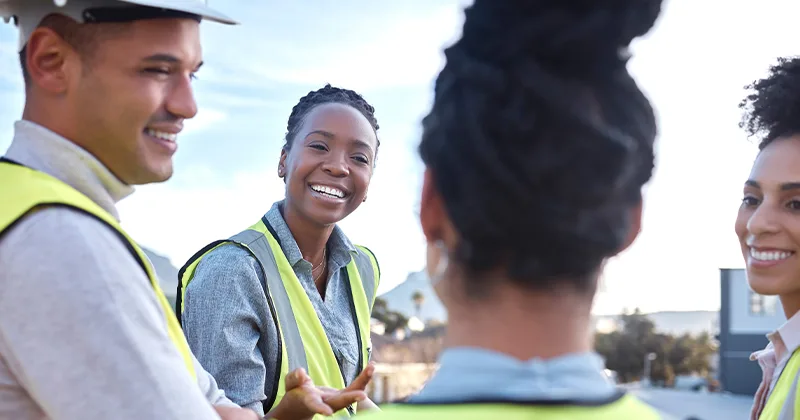11 mins read
The RIB Construction Sustainability Report 2024 – A Status Quo Analysis of the AEC Industry
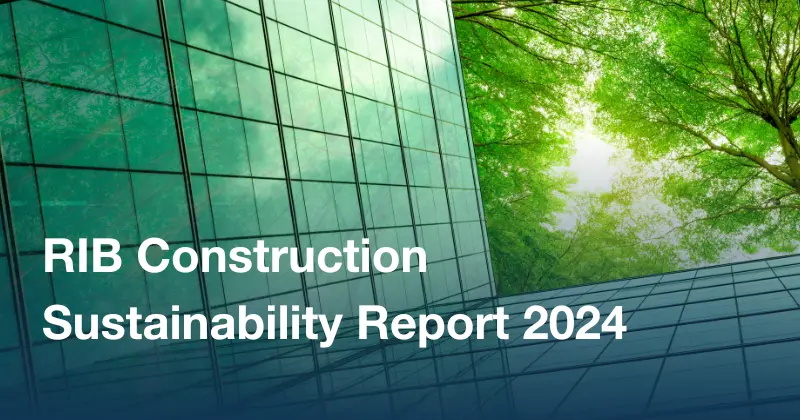
- What is Sustainable Construction?
- Embodied Carbon Emissions in Construction: A Comprehensive Overview
- The Role of Embodied Carbon for Sustainability in the Construction Industry
- Carbon Reduction Throughout the Construction Project Lifecycle
- What is the Importance of Sustainable Construction?
- Methodology & Sources of the Construction Sustainability Report
- Key Results & Findings of the RIB Sustainable Construction Report
- Summary, Main Insights & Outlook
Sustainability and the urgent need to reduce embodied carbon have become a global concern. As the world’s most significant contributor to global energy-related greenhouse gas emissions, accounting for a concerning 37%, the Architecture, Engineering, and Construction (AEC) industry can no longer ignore the alarm bells.
Reducing carbon emissions has moved to the front of our priority queue as the planet scrambles to secure an efficient, sustainable and resilient future. As an important cog in the built wheel, the AEC industry has the power to both mitigate its ecological footprint and develop innovative solutions that can live in harmony alongside nature.
RIB Software’s vision of ‘making engineering and construction more efficient and sustainable’ hinges on our ability to support and initiate positive change within the industry. That is what prompted us to reach out to our global customer networks and hear their thoughts, perspectives and experiences dealing with this sensitive yet incredibly relevant topic.
For a second year, we compiled these findings into a construction sustainability report that unpacks the worrying issue of embodied carbon emissions in the industry, a silent yet significant contributor to our environmental challenges. The insights drawn from our sustainability in construction survey illustrate the industry’s current stance on embodied carbon tracking and what comes next for the industry, helping us understand where we need to put our efforts to develop the best construction software solutions to ensure a greener future for the AEC industry.
What is Sustainable Construction?
Sustainable construction refers to all the processes, tools, and methods that minimize the environmental impact of the entire project lifecycle, from planning and design to construction, operation, maintenance, renovation, and eventual demolition or decommissioning.
Sustainability in the AEC industry covers every aspect of the build process, from green construction materials to reducing energy consumption and resources, minimizing waste, and considering a project’s social and economic factors. The ultimate goal of sustainable construction is to meet the needs of the present without compromising the ability of future generations to meet their own needs.
Embodied Carbon Emissions in Construction: A Comprehensive Overview
Simply put, embodied carbon refers to the carbon dioxide (CO2) emissions associated with the manufacture and use of a product or service. In the construction arena, this encompasses the carbon emissions released during the lifecycle of building materials, including raw material extraction, manufacturing, transport, construction, and eventual disposal or recycling. Examples of materials that contribute to embodied carbon emissions are steel, concrete, and insulation.
Scope 1 Emissions: These are directly caused by a company operating things it controls and/or owns. They result from the direct use of fossil fuels and industrial activity. Examples include equipment, on-site generators, and vehicles used during the building process.
Scope 2 Emissions: These are caused indirectly through the consumption of purchased electricity, heat, or steam. These include energy used in construction sites for equipment and temporary site facilities. Strategies for reducing this scope may include installing solar panels or sourcing renewable energy.
Scope 3 Emissions: Like scope 2, these are indirect emissions, but they relate to all other greenhouse gas emissions that companies have no direct ownership or control over, i.e., those occurring throughout their value chain, such as material extraction, manufacturing, transportation, and others.
The Role of Embodied Carbon for Sustainability in the Construction Industry
Embodied carbon in construction refers specifically to the CO2 emissions associated with the materials and processes used to create and construct a building. This includes the carbon emitted during the extraction, manufacturing, transportation, and installation of building materials like concrete, steel, glass, insulation, and more. Essentially, embodied carbon measures the environmental impact of a building’s materials and construction methods before it even starts operating.
Understanding and reducing embodied carbon is crucial for achieving sustainability goals in the building industry. As buildings become more energy-efficient during their operational phase (Scope 1 and Scope 2), the proportion of emissions attributed to embodied carbon (Scope 3) becomes increasingly significant. Thus, focusing solely on operational emissions while neglecting embodied carbon undermines the overall sustainability efforts of the construction sector.
In the journey toward a more sustainable built environment, it’s imperative for the construction industry to address both operational and embodied carbon emissions. By minimizing the embodied carbon associated with construction materials and methods, the industry can substantially contribute to the reduction of its environmental footprint and work towards a net-zero emissions future.
Carbon Reduction Throughout the Construction Project Lifecycle
Carbon reduction in a sustainable construction project is a collaborative effort involving various stakeholders, each with a unique role in minimizing the project’s environmental impact.
1) Architects and Designers
At the start of a project, architects and designers can already drive carbon reduction during the design phase with the help of professional construction software for architects:
Material Selection: Choosing low-carbon materials, such as those with lower embodied carbon, sustainable certifications, or recycled content, can make a noticeable impact on the overall carbon footprint of a project.
Energy Efficiency: Energy-efficient buildings reduce operational carbon emissions. These professionals can make a marked difference by choosing passive design strategies, optimizing daylighting, and including renewable energy sources.
2) Engineers
Structural, mechanical, and electrical engineers also have a part in carbon education:
Structural Efficiency: Reliance on structures that use fewer materials while maintaining structural integrity will reduce embodied carbon emissions.
Systems Design: Efficient HVAC, lighting, and water systems are responsible for lower operational carbon emissions.
Renewable Energy Integration: Engineers can minimize reliance on fossil fuels by designing systems that harness renewable energy sources, such as solar panels and geothermal heating. With the help of innovative construction tools for engineers, renewable energy can be at the core of any modern building.
3) Contractors and Builders
Contractors play a vital role in transforming green designs into reality:
Construction Practices: Adopting efficient building methods and minimizing waste.
Supply Chain Management: Selecting suppliers that provide low carbon materials and optimized transportation routes.
Efficient Site Operations: Creating energy-efficient construction site facilities and temporary power systems.
4) Suppliers and Manufacturers
Suppliers and manufacturers can contribute by producing and providing low-carbon materials and products:
Sustainable Materials: Developing and supplying reduced embodied carbon materials, such as recycled materials or those produced with lower-energy processes.
Supply Chain Transparency: Access to data on the carbon footprint of products helps inform decision-making during the material selection process.
5) Clients and Developers
Clients and developers drive carbon reduction by setting priorities and expectations:
Setting Sustainability Goals: If clients prioritize carbon reduction in project goals, it will align all participants with the common goal of minimizing environmental impact.
Demanding Transparency: Detailed information on the carbon footprint of materials and construction practices prompts transparency and accountability across the project team.
6) Regulatory Bodies and Government
Regulatory bodies and government agencies establish guidelines and incentives that promote carbon reduction:
Building Codes: Setting stringent building codes prioritizing energy efficiency and low-carbon materials.
Incentives: Offering incentives, such as tax credits or grants for sustainable construction.
Collaboration in construction is essential to achieve meaningful carbon reduction across all projects. Effective communication, shared goals, and a commitment to sustainability at every stage of the project contribute to a more environmentally responsible built environment.
What is the Importance of Sustainable Construction?
As the global community becomes more aware of the environmental impact of various industries, sustainable construction practices have gained significant attention. The building industry generates ~40% of global energy-related greenhouse gas emissions per year, 11% of which are embodied carbon emissions related to new construction. To achieve the net zero goal, the industry must reduce carbon emissions by the same amount.
As with any other sector, sustainability in construction is essential for mitigating environmental impacts, conserving resources, reducing costs, enhancing occupant health and well-being, and meeting regulatory requirements and market demand.
Methodology & Sources of the Construction Sustainability Report
RIB recognizes the existing sustainability emergency in buildings and the vital role that construction plays in shaping a greener future. We are committed to driving positive change within our industry, delivering on our purpose of making engineering and construction more efficient and sustainable. This was the impetus for us to reach out to our global customer networks to hear their thoughts and perspectives on this crucial topic, with a special focus on embodied carbon emissions in construction.
The RIB Sustainable Construction Report was split into two sections. The first section included a set of mandatory questions on which we wanted our customers’ feedback and insights the most. The second section was optional to complete.
The survey captured 157 unique responses from respondents working in the architecture, engineering, and construction industry, specifically in contractors and owners across Asia Pacific, Europe, the Americas, and the Middle East & Africa from October 14th to October 30th, 2024. The responses were then anonymized and aggregated to ensure privacy and data security.
Key Results & Findings of the RIB Sustainable Construction Report
To put the answers to the survey into perspective, we will compare the results with last year’s edition to gain a deeper understanding of where we are going as an industry.
1) Tracking of Embodied Carbon Emissions: “Have you estimated the embodied carbon emissions related to your projects?”
Our first question aimed at quantifying the percentage of respondents who have already begun the tracking process. As anticipated, we discovered that the majority of the regions surveyed are not tracking embodied carbon, with the ones that are only tracking it on a small majority of their projects.
The answers indicate that despite the topic’s importance, relevance, and urgency, 70% of companies are still not tracking their projects’ embodied carbon. Of the remaining 30% that are tracking it, only 9% are doing it on all projects. This shows a concerning lack of prioritization in measuring and mitigating carbon emissions, which will be explained by factors mentioned later in the survey.

That said, regardless of the concerning percentages found in the report, there is a slight improvement compared to 2023, with the percentage of companies not tracking carbon emissions decreasing from 74% to 70%. While this is a small percentage, it indicates a gradual shift towards awareness and accountability.
2) Reasons for not Tracking Embodied Carbon Emissions: “Why are you not measuring and/or tracking embodied carbon on your projects?”
The second question from our sustainable construction report delved deeper into the reasons why embodied carbon tracking is not taking place, which shines a light on the percentages from the first question.
The survey identified two primary reasons for not tracking it:
- 48% of respondents noted that it’s not a priority for their clients
- 25% cited a lack of knowledge about measurement techniques
Less prevalent responses included cost concerns, fears about its impact on schedules, and apathy about the degree of meaningful change individuals can bring about.
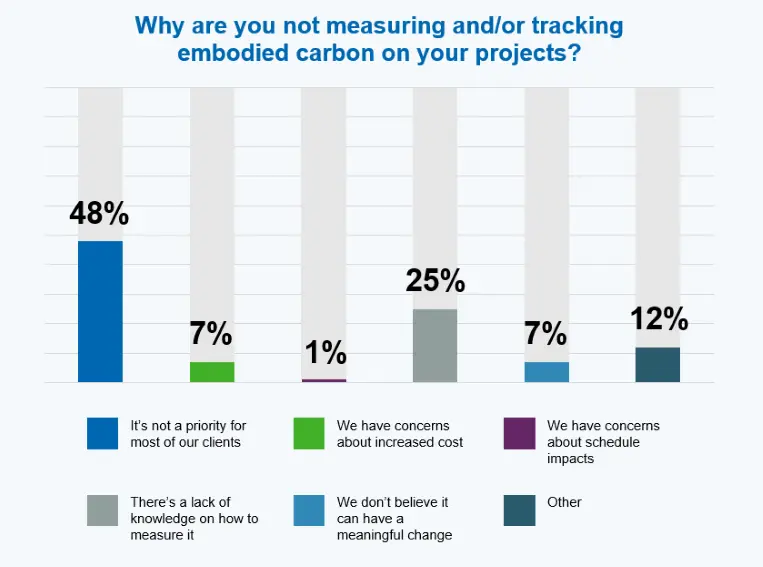
The answers to this question indicate that tracking embodied carbon will not be a priority for companies until clients start to demand it, with this reason increasing from 45% in 2023 to 48% in 2024. This is not entirely surprising, as many industries have leaned into sustainability due to consumer pressure.
25% of respondents cited a lack of knowledge about measuring embodied carbon as the second main reason for not tracking it. This shows how important education is in creating a paradigm shift in industry practices.
3) Motivations for Tracking Embodied Carbon: “Why are you measuring and/or tracking the embodied carbon related to your projects?”
The responses to the third question in our survey revealed that 26% of respondents track carbon emissions to meet client sustainability goals. This is not surprising, as we saw a lack of client interest as the main reason for not tracking it in the previous question.
That said, another 26% of respondents across all major regions said a key reason for measuring and/or tracking the embodied carbon related to projects is meeting one’s own company’s sustainability needs and goals. This percentage highlights companies’ interest in aligning their internal objectives with client expectations, showing a shared positive commitment.

As for the other reasons, 15% cited regulatory pressure as the third leading reason for tracking it. This is an increase from 12% in 2023, showing how regulators are increasing emphasis on sustainability.

4) Time and Impact Assessment: “How long have you been measuring and/or tracking embodied carbon on your projects?”
For those respondents who have been tracking their emissions, the large majority have only been doing it for a very short period of time. The survey revealed that 83% of those tracking embodied carbon emissions have been doing so for less than five years.
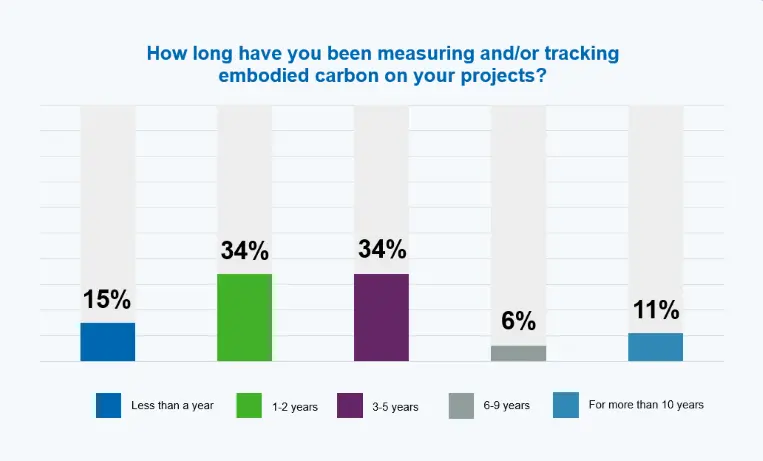
5) Perceived Impact of Tracking Implementation: “On average, what is the estimated percentage of embodied carbon emissions you have managed to reduce on your projects since being able to track and measure it?”
The survey makes a noteworthy observation: The perceived impact of the embodied carbon tracking efforts is low. 34% say it is between 11% and 20%, followed by 26% who say it is less than 10%.
This could be due to several factors, including incorrect tracking, the unavailability of low-carbon resources, design constraints, or a lack of collaboration, just to name a few.

6) Perception and Responsibility: “How much of the globe’s total carbon emissions do you think the AEC industry accounts for?”
The 2024 survey shows an encouraging shift in accountability and perception in the AEC industry. 49% of respondents said the AEC sector accounts for 20-40% of the total global carbon emissions, a positive increase from 44% in 2023. Respondents who thought it accounted for less than 20% decreased from 26% to 14%, showing progress in terms of accountability.
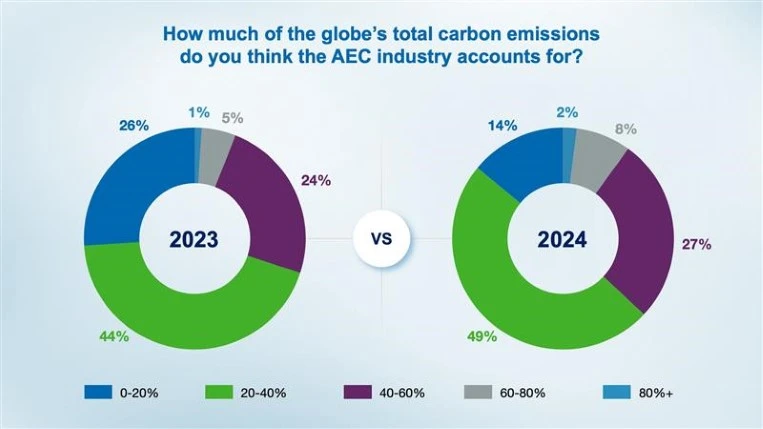
Another encouraging insight from the survey is that 60% of respondents believe that companies and people involved in the AEC industry must do more to reduce carbon emissions. 58% recognize themselves as part of that group, a positive increase from 48% the previous year.
7) Green Projects and Strategies: “What is the share of green projects* in your company?”
*In our survey, we defined a green project as the build of an asset that, because of its construction and features, can maintain or improve the quality of life of the environment in which it is located.
The survey revealed that less than 30% of projects are classified as green for over half of the respondents (59%).

Only 36% of the surveyed companies have carbon reduction strategies in place, an increase from 32% in 2023, while 47% have dedicated staff for sustainable initiatives, compared to 45% last year. These figures signify an uneven distribution of commitment across the industry.

8) Formal Commitments and Drivers for Change: “What do you think the drivers for change are?”
Although the survey results indicate a gloomy picture at present, a promising insight has emerged. 39% of companies committed to reducing embodied carbon emissions, a positive step forward from 32% last year. This commitment is driven by a variety of factors, with legislation (25%), client expectations (25%), and cost/efficiency savings (13%) emerging as the primary catalysts for change.
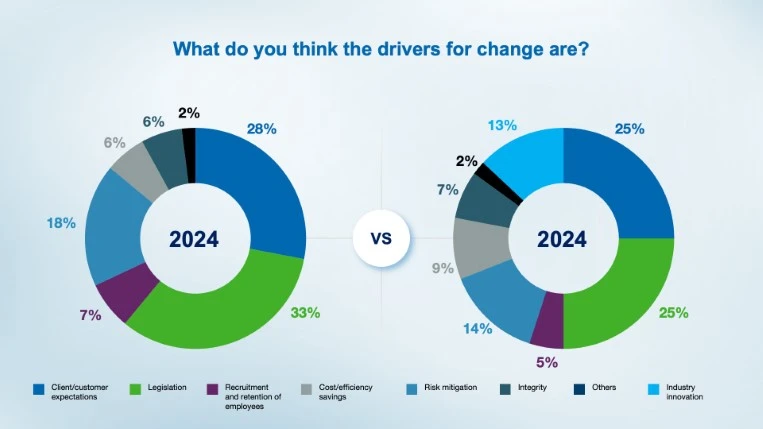
Summary, Main Insights & Outlook
As seen in the answers from our report, the AEC industry still has a long way to go when it comes to the topic of sustainability. While respondents have a level of awareness and accountability, most still don’t take action to track and mitigate their project’s carbon emissions. The main reason for this is a lack of prioritization from clients around sustainability, with the second biggest reason being a lack of understanding and education about how to measure emissions.
Despite this gloomy picture, there is light at the end of the tunnel, as sustainability is being discussed and implemented slowly but surely. At RIB Software, we take our role in this mission quite seriously, offering our users various educational resources and professional embodied carbon software to support their carbon mitigation efforts.
Achieving a meaningful reduction in carbon emissions across the entire lifecycle of a project requires collaboration, technology, and, above all, commitment. Below are a few actions businesses can take at each stage of the project lifecycle:
- Planning & Design: Some actions companies can take during the planning stage is to invest in digital twin technology to simulate energy performance, material use, and the carbon emissions of different design choices. That way, sustainability principles can be integrated into the project from the get-go.
- Preconstruction: During preconstruction, companies can ensure sustainable supply chain management by partnering with suppliers committed to carbon-neutral practices. They can also source sustainable materials and minimize waste by investing in prefab and modular construction.
- Construction: During the construction phase, they can educate teams on sustainable practices, use low-emissions equipment, implement energy-efficient operations, and implement waste recycling systems. They can also track energy usage and emissions in real time to adapt as needed.
- Operation & maintenance: Lastly, during the operation and maintenance phase, they can implement a number of systems to monitor and optimize energy consumption in real-time. They can also ensure that HVAC or lightning systems are continuously updated to maintain energy efficiency and use analytics software to track performance and improve when needed.
The construction industry has a huge role to play. It is tasked with not just erecting structures but also building a sustainable legacy. As participants in this dynamic landscape, we must drive transformation, advocate for informed decisions, and pioneer innovative strategies that lead to a future where efficiency and sustainability are not just goals but a way of life.
If you want to start your green journey with state-of-the-art sustainable construction software, get your free demo of RIB’s toolkit today!
Most Recent
11 mins read
10 mins read
10 mins read
29 mins read
Blog Categories

Ebook










